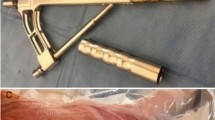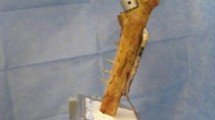Abstract
Introduction
The most common implants for treating unstable femoral neck fractures are sliding constructs, which allow postoperative collapse. Successful healing, typically, is a malunion with a shortened femoral neck. Functional sequelae resulting from altered femoral neck biomechanics have been increasingly reported. Re-operation rate due to nonunion, avascular necrosis, hardware cut-out and prominence is high with this treatment modality. We evaluated the outcomes of patients with femoral neck fractures treated with stable calcar pivot reduction, intraoperative compression across the fracture, and stabilization with length-stable implants.
Materials and methods
Fifty-four patients with femoral neck fractures underwent open reduction and internal fixation. Average follow up duration was 23.6 months (range: 15–36 months). There were 23 Garden I, 2 Garden II, 14 Garden III and 15 Garden IV fractures. Reduction was achieved through a modified Smith-Petersen approach. Fractures were compressed initially, and subsequently stabilized with a length-stable device. Post-operative radiographs were assessed for change in fracture alignment. Variation in the femoral neck offset and abductor lever arm measurements was performed using the contralateral hip as control. Functional outcome was assessed using SF-36, Harris Hip Score (HHS) and a gait analysis device. The average patient age was 78 years. Fifty-one (94%) healed without complications. Surgical fixation failed in two patients and one patient developed avascular necrosis. The average femoral neck shortening was 1.7 mm.
Results
The average difference in femoral neck offset and the abductor lever arm measurement at the latest follow up was 3.5 and 1.5 mm respectively. The average score on physical, mental components of SF-36 and HHS was 42 and 47 and 87 respectively. By 6 months, patients on average recovered 94% of the single limb stance time, 98% of cadence, 90% of cycle duration, 96% in stride length compared to the uninjured side.
Conclusion
Reduction with a stable calcar pivot, intraoperative compression and length-stable fixation can achieve high union rates with minimal femoral neck shortening and improved functional outcomes.
Level of evidence
IV, retrospective with historical controls.






Similar content being viewed by others
References
DeFrances CJ, Cullen KA, Kozak LJ (2007) National Hospital Discharge Survey: 2005 annual summary with detailed diagnosis and procedure data. Vital Health Stat 13 165:1–209
Lu-Yao GL, Keller RB, Littenberg B et al (1994) Outcomes after displaced fractures of the femoral neck. A meta-analysis of one hundred and six published reports. J Bone Joint Surg 76:15–25
Tidermark J, Zethraeus N, Svensson O et al (2002) Quality of life related to fracture displacement among elderly patients with femoral neck fractures treated with internal fixation. J Orthop Trauma 16:34–38
Zlowodzki M, Ayieni O, Petrisor BA et al (2008) Femoral neck shortening after fracture fixation with multiple cancellous screws: incidence and effect on function. J Trauma 64:163–169
Parker MJ, Blundell C (1998) Choice of implant for internal fixation of femoral neck fractures. Meta-analysis of 25 randomised trials including 4,925 patients. Acta Orthop Scand 69:138–143
Bhandari M, Devereaux PJ, Swiontkowski MF et al (2003) Internal fixation compared with arthroplasty for displaced fractures of the femoral neck. A meta-analysis. J Bone Joint Surg 85-A:1673–1681
Swiontkowski MF, Winquist RA, Hansen ST Jr (1984) Fractures of the femoral neck in patients between the ages of twelve and forty-nine years. J Bone Joint Surg Am 66:837–846
Parker MJ (1994) Parallel Garden screws for intracapsular femoral fractures. Injury 25:383–385
Parker MJ, Porter KM, Eastwood DM et al (1991) Intracapsular fractures of the neck of femur. Parallel or crossed garden screws? J Bone Joint Surg Br 73:826–827
Bray TJ (1997) Femoral neck fracture fixation. Clinical decision making. Clin Orthop Relat Res 339:20–31
Zlowodzki M, Jonsson A, Paulke R et al (2007) Shortening after femoral neck fracture fixation: is there a solution? Clinical orthopaedics and related research 461:213–218
Sakalkale DP, Sharkey PF, Eng K et al (2001) Effect of femoral component offset on polyethylene wear in total hip arthroplasty. Clin Orthop Relat Res 125–134
McGrory BJ, Morrey BF, Cahalan TD et al (1995) Effect of femoral offset on range of motion and abductor muscle strength after total hip arthroplasty. J Bone Joint Surg Br 77:865–869
Charles MN, Bourne RB, Davey JR et al (2005) Soft-tissue balancing of the hip: the role of femoral offset restoration. Instr Course Lect 54:131–141
Davey JR, O’Connor DO, Burke DW et al (1993) Femoral component offset. Its effect on strain in bone-cement. J Arthroplasty 8:23–26
Ito K, Minka MA 2nd, Leunig M et al (2001) Femoroacetabular impingement and the cam-effect. A MRI-based quantitative anatomical study of the femoral head-neck offset. J Bone Joint Surg Br 83:171–176
Hays RD, Morales LS (2001) The RAND-36 measure of health-related quality of life. Ann Med 33:350–357
Harris WH (1969) Traumatic arthritis of the hip after dislocation and acetabular fractures: treatment by mold arthroplasty. An end-result study using a new method of result evaluation. J Bone Joint Surg 51:737–755
Gardner MJ, Barker JU, Briggs SM et al (2007) An evaluation of accuracy and repeatability of a novel gait analysis device. Arch Orthop Trauma Surg 127:223–227
Zhang K, Werner P, Sun M et al (2003) Measurement of human daily physical activity. Obes Res 11:33–40
Liporace F, Gaines R, Collinge C et al (2008) Results of internal fixation of pauwels type-3 vertical femoral neck fractures. J Bone Joint Surg 90:1654–1659
Alho A, Benterud JG, Ronningen H et al (1992) Prediction of disturbed healing in femoral neck fracture. Radiographic analysis of 149 cases. Acta Orthop Scand 63:639–644
Saito N, Miyasaka T, Toriumi H (1995) Radiographic factors predicting non-union of displaced intracapsular femoral neck fractures. Arch Orthop Trauma Surg 114:183–187
Mathiesen T, Zayer M (1989) A prognostic algorithm for assessment of subcapital femoral neck fractures. Acta Radiol 30:639–642
Molnar RB, Routt ML Jr (2007) Open reduction of intracapsular hip fractures using a modified Smith-Petersen surgical exposure. J Orthop Trauma 21:490–494
Deneka DA, Simonian PT, Stankewich CJ et al (1997) Biomechanical comparison of internal fixation techniques for the treatment of unstable basicervical femoral neck fractures. J Orthop Trauma 11:337–343
Bjorgul K, Reikeras O (2007) Outcome of undisplaced and moderately displaced femoral neck fractures. Acta Orthop 78:498–504
Tidermark J, Ponzer S, Svensson O et al (2003) Internal fixation compared with total hip replacement for displaced femoral neck fractures in the elderly. A randomised, controlled trial. J Bone Joint Surg Br 85:380–388
Author information
Authors and Affiliations
Corresponding author
Additional information
This article has been retracted due to plagiarism.
The retraction note to this article can be found online at http://dx.doi.org/10.1007/s00402-012-1487-6.
Investigation performed at hospital for special surgery.
About this article
Cite this article
Boraiah, S., Paul, O., Gardner, M.J. et al. RETRACTED ARTICLE: Outcomes of length-stable fixation of femoral neck fractures. Arch Orthop Trauma Surg 130, 1523–1531 (2010). https://doi.org/10.1007/s00402-010-1103-6
Received:
Published:
Issue Date:
DOI: https://doi.org/10.1007/s00402-010-1103-6




